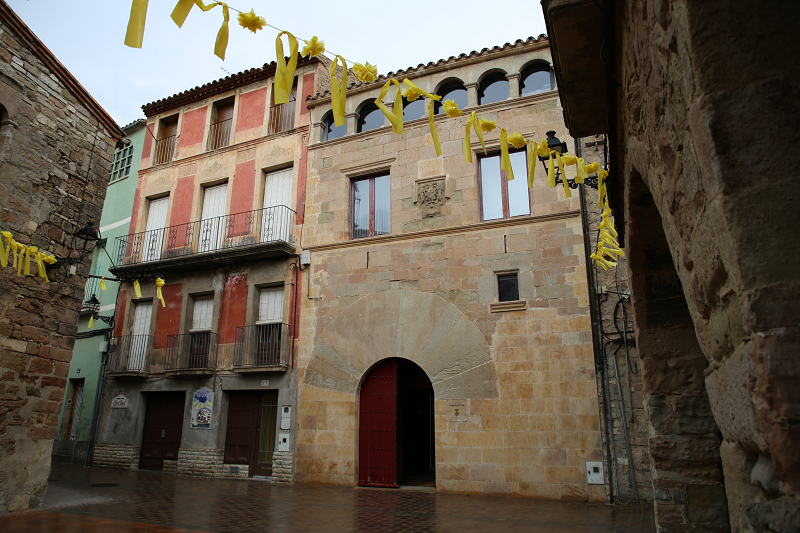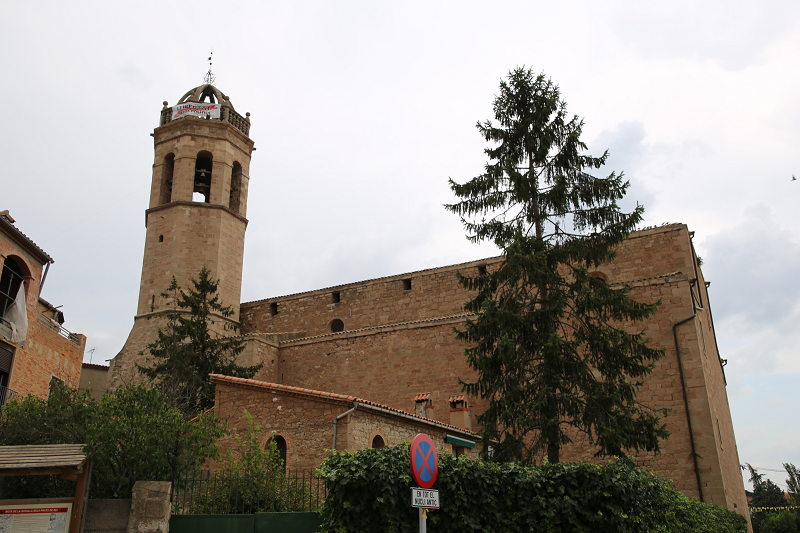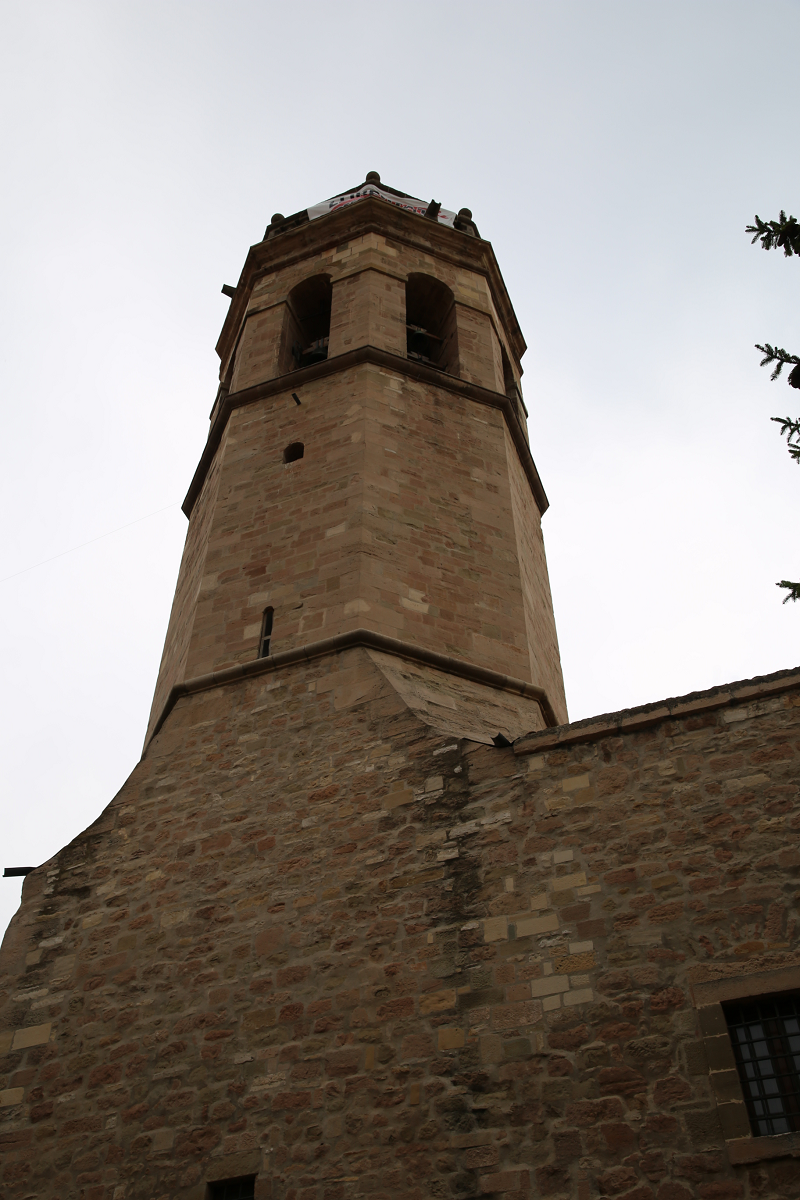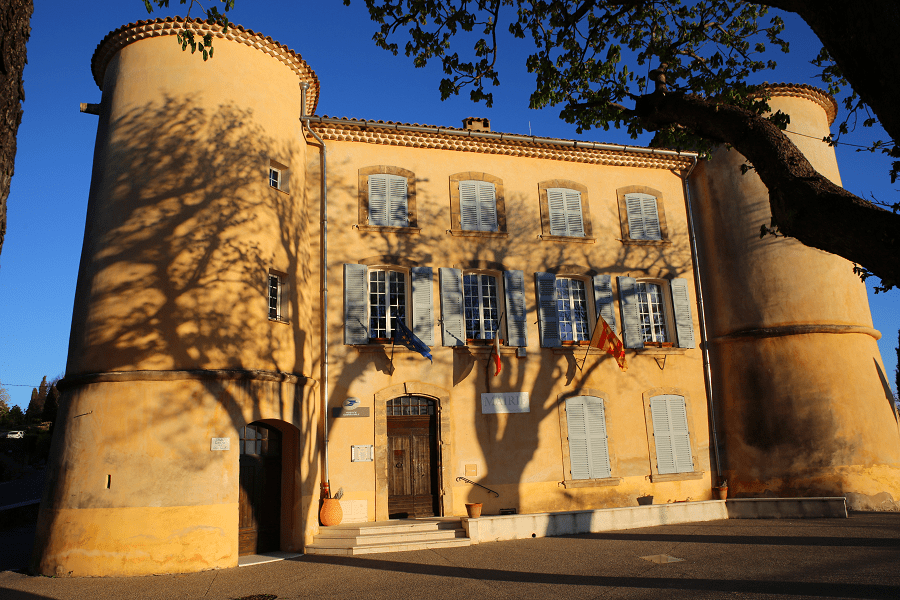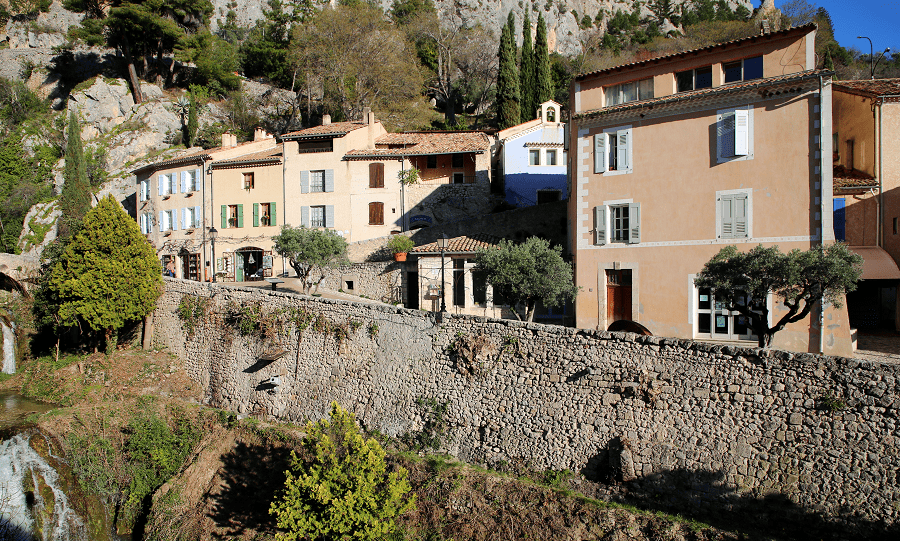Prats de Rei is a city and municipality in Spain located on the Segarrencs plateaus of the Anoia region, Catalonia, in one end of the Central Depression and in the center of a small valley formed by the young river Anoia, beginning its descent into the basin of the Conca d’Òdena.
The municipal territory is of capricious and irregular forms, it is bordered by municipalities of Calaf, Sant Martí de Sesgueioles, Pujalt, Veciana, Sant Pere Sallavinera, Aguilar de Segarra and Rubió. The strange form of the district boundaries is due to the annexations of ancient quarters, districts and jurisdictions, and to privileges granted in very past times.
The municipality is formed by the Prats de Rei town, located in the center of the municipality, and by the urban centers and villages of La Manresa, Solanelles, Puigdemàger, Seguers and Quadra del Galí.
The economy nowadays is very diversified. It has gone from a quasi-total predominance of agriculture to a quite significant distribution in other industrial, commercial, service sectors, etc. In the village there are small industries of clothing, carpentry, sawmill, metallurgy, flour milling.
In commerce there has been a significant decline in recent years. Stores have been closed until they reach the current situation: three grocery stores – two of which are also bakeries – and a large area dedicated to the sale of clothes. There are also farms of pigs and rabbits.
About 60% of the land is devoted to the cultivation of dry land grains, mainly wheat and barley, although it is currently being experimented with other seeds such as rapeseed. Years ago, before the phylloxera destroyed the vineyards, wine production was quite important. Almost all farmers had planted vines. The local people still refer to their parcels of land commonly as “the vineyard” and many houses still hold a cellar and a winery. Recently, some young entrepreneurs have pushed the return of the vineyard to the area.
On the other hand, the remaining 40% of land is occupied by forest. The predominant trees are white pines and black pines. There are also small nuclei of oaks, kermes oaks and especially the evergreen oaks.
Also grown, although on a small-scale are vegetable garden products, and they are almost entirely centered on the fields that border the banks of the river Anoia, which are used almost exclusively for self-consumption.
The climate of the area is extreme and of continental nature, with cold winters, with fog, snow and ice; and dry and hot summers. However, rainfall tends to occur at the necessary time, and thanks to this despite being a dry land country, cereal crops here are comparatively the highest in Catalonia.
Tourist attractions, architecture and what to see?
Historic Medieval Monumental Center
The Prats de Rei is one of the few towns in Catalonia in which we find traces of various civilizations, and the historical center is full of their testimonies.
The historical center of the old walled town of the Prats de Rei maintains the entire passage of all these times. Its old layout, with narrow medieval streets full of remarkable buildings, shares a place with memories of a Roman past. The historical quarter, together with the monumental complex of the Torre del castell de la Manresana, is the area of greatest tourist interest in the town.
Reflection of the glorious medieval era is the porticoed Main Square (Plaça Major). It is the nerve center of the Prats de Rei, where the markets and public events once were taking place. The main festive and cultural acts of the municipality are currently still being held there.
Town hall. Presiding over the Plaza Mayor you will find the historical building, an example of Gothic architecture that is now occupied by the Town Hall (l’ Ajuntament). It is the most emblematic and prominent building in the square, along with “Cal Jona”, which is on the corner with Carrer Nou. Constructed at the end of the 16th century, as can be read on the shield of the town that presides over the façade (1591), from the current that can be considered Renaissance or by some authors define as a Gothic Catalan. Entry is a large portal with voussoirs. On the first floor, two windows with molded lintels flank the aforementioned shield, supported by two rampant lions; And in the attic there is a gallery of six arches or arcades supported by columns. Despite it’s modesty , the building maintains a stately and noble character. The current municipal coat of arms of the Prats de Rei, is basically the same thing that appears on the facade of the Town Hall. It was approved on June 16, 1983. It is quartered, the first and fourth on silver, three roses of gules (red heraldic) as a signal referring to the name of Prats, and the second and third, the four bars, which are distinguished only by the royal villas. The present shield, in addition, has a stamp of a crown that distinguishes it as a town.
Carrer Nou. Crossing the entire historic center, we find the longest and widest street, the Carrer Nou. Formerly it was the street of commerce and trade. Its buildings retain great entrances which are reflections from the various workshops and stores that had previously occupied them, even today many of the ground floors are called “the store” commonly.
The name ‘New’ Street (“Nou”) comes from the medieval era, as the need to expand the city walls led to its creation. Today, at Carrer Nou, there is no store left and many houses are uninhabited. The street that ones had been center of commerce of the region has become a route of old houses, some in a ruined state. Despite of it, the individual interventions of owners have given impetus to the restoration and reform of some buildings.
Examples of historical and monumental houses are “Cal Arrapat”, with two impressive Romanesque vaults in its interior, “Cala Corona”, “Cal Claret” or “Cal Pits”.
Parallel to the new street, and leading to the main square (Plaça Major), is the Isidro Forn Street (Carrer Isidre Forn), or commonly called Carrer del Mig. It is a narrow and long street with deep historical memory. Its morphology suggests the way of medieval construction, based on buildings invading public spaces to take advantage of the space available inside the town walls. The upper floors of the houses rise and join up to give it an attractive romantic atmosphere.
The Carrer del Forn connects the main square (Plaça Major) with which it had been a vestibule of entrance to the city walls. The origin of its name is due to the fact that the old communal oven (forn) of the village was located here. Its conformation is also a narrow and tumultuous medieval passage.
The Church Street (el Carrer de l’Església) joins the Main Square (Plaça Major) with the parochial church dedicated to Santa Maria, which is baroque, and was built between 1685 and 1713. The present baroque temple occupies the site of the primitive church, granted in 945 by the bishop of Vic to the monastery of Santa Cecília de Montserrat. The building with a single nave, with two sacristies – one of which retains a door that gives access to a cupboard with a shield dated in 1713 and a baroque baptismal font, and six side chapels per side of which one became way to the side access door, and another is the chapel of the Blessed Sacrament that served as the pantheon of the Llobet family, whose coat (a small wolf) is preserved on the door of a small sacristy. In one of the chapels, under the choir, the original capital of the wayside cross is preserved, of which today we can see reproduction in front of the Sanctuary de la Mare de Déu del Portal. The old Baroque altar, by Joan Pons (1794), destroyed during the 1936 Civil War, was replaced by an image of the Assumption of Mary surrounded by angels; at the key of the vault of the presbytery the shield of the Prats de Rei is conserved. The main façade of a very austere baroque features the entrance door architrave with a round eardrum, a rose window and an oculus. The square base bell tower becomes octagonal at the height of the roof, being crowned by a balustrade. The wall opposite to the main façade has two windows with eighteenth-century shields and a niche with the Virgin and the Child.
In 1594 the parish church of Santa Maria dels Prats de Rei was added to Sant Joan del Laterà, one of the four jubilee basilicas of Rome.
Inside the parochial temple, on the door of the sacristy, in the corner of the epistle, worth mentioning, is hanging a splendid oil painting on cloth from the old doors of an organ from the second half of the 17th century, with the theme of the Annunciation. We find on it the Virgin Mary kneeling on the landing of stairs, with her arms open and with a sign of acceptance of the message of the archangel Saint Gabriel. The archangel is represented on clouds, as was usual to find after the Council of Trento. To the right hand it carries some iris and with the other hand it indicates the Holy Spirit by whose work it was incarnated to the Virgin Mary.
In the hallway of the side door of the parish church of Santa Maria, five tombstones dating from the 1st to 3rd centuries are conserved, one of them dedicated to Caius Annius Proculus is a reproduction of the original one preserved in the Museu d ‘ Archeology of Catalonia, where there is also a sixth honorable tomb dedicated to Maximian emperor.
This epigraphic material allows us to know first hand something of the name of the city in Roman times (Sigarra of clearly indigenous origin) its legal structure, its governing organization and its inhabitants. We know that it had the status of municipium, attached to the tribe Galeria, who probably only enjoyed Latin law and who obtained the right of citizenship under the reign of Emperor Augustus, making a parallel with the nearby city of Lesso (Guissona). The tombstone dedicated to Maximian emperor, who subsequently replicated following the Damnatio memoriae, is dedicated to Ordo Segarrensis, a municipal government structure composed of four people (IIII viri = II Viri + two aediles) documented in the dedication tomb made to Caio Vibio Luperco.
Behind Santa Maria of Prats de Rei we find the Roman necropolis. In the years 1972-1973, in front of the rectory of the parish church of Santa Maria, a necropolis was excavated, which was later rebuilt in the present place. During the 1972 and 1975 period the archaeological activity of the members of the Municipal Museum of the Prats de Rei was very intense and fruitful, revealing remarkable Roman and Iberian remains, during the works carried out in the square that is in front of the Parochial church, at the foot of the sanctuary of the Virgin of the Portal and the Field of the Farinera or the Plana del Solà.
This set of burials located around the apse of the parish church of Santa Maria, consists of six stone tombs, using one of the same Roman flat roofs as a headboard or bed, and two sarcophags. A stone wall was also part of the enclosure that was also rebuilt in its new location. The tombs are dated between the 4th and 7th centuries AD and correspond to the primitive Paleo-Christian church.
The great difficulty faced by scholars is to identify the reason why a Roman municipality arose in this territory, and obviously, following the Roman mentality, what were its means of financing and obtaining economic resources. It is clear that an important factor is the geographical situation that in subsequent centuries also influenced the development and importance of the Prats. The street of the church also contemplates other monumental buildings such as the old ‘Study’(“Estudi”), “Cal Peira” o “Cal Pere del Cens”.
One of the most magical corners of the old fortified town of the Prats de Rei is Carrer de Baix. It joins the street of the church with the Plaça de la Sardana. Formerly it was a blind street that led to the wall. The street starts wide in the church area and becomes narrow as it goes down, as its name suggests. The lowest area is dark and shady, which gives it a peculiar charm and sonority.
Abat street (carrer Abat) was created as a result of the destruction of the walls to “aerate” the urban center. It joins Carmen Muñoz Street with Paseig José Maria Llobet.
Carmen Muñoz Street joins Carrer del Forn with carrer del Mur. Formerly it was the street that gave access to the main portal of the wall. In addition to historic houses such as “Cal Carabrut” and “Cala Maria Codina”, there is a reproduction of the gothic wayside cross that is conserved inside the sanctuary of the Mother of God of the Portal (la Mare de Deu del Portal), with crucified Jesus on one side and the Virgin Mary to the other. The cross is based on the octagonal capital of the column, with sculpted reliefs of saints on each of its faces. The cross dates back to 1497 and is the work of the sculptor ‘master of image’ (“mestre d’imatges”) Pere Joan of Spain, known for works in the large rosette of the church of Santa Maria del Mar in Barcelona.
In the tympanum one can read “Regnante Carolo III 1781”. The site of the old Baroque altar was decorated in 1945 by paintings, designed by vigatà M. Costa. The image of the Virgin that is worshiped here is a Saulo-Roman stone sculpture, of about 70 cm, Gothic style, dated between the end of the 14th century and the 15th century, later policromed; represents the Virgin sitting, carrying a scepter in the right hand and holding the Child, standing on her right knee – who carries a cell in his left hand and with his right hand in an action of blessing.
Legend says that the Virgin of the Portal has performed several prodigious miracles. In 1761 it was walked in a procession through the streets of the town on the occasion of a devastating plague that hit the population; After this act of faith all the sick, even the most seriously, recovered. It also has it that in the course of the construction of the current sanctuary, the church columns were moved on January 27, 1782 with a four-wheeled car, with such bad luck that one of them was detached, leaving the Isidre Vilar’s thigh very badly injured; under the protection of the Virgin he was cured without any difficulty. It also cites how when the workers took care of placing beams in the highest part of the half dome, on the following day after the Reis of the year 1786, and one of them – Jacint Gallés fell from this great height, and protected by the Virgin was able to go home on his own foot.
How to get to Els Prats de Rei?
From Barcelona 1 hr 8 min (86.3 km) via A-2
From Madrid 5 hr 39 min (549 km) via A-2
From Andorra 1 h 48 min (120 km) via C-14 and C-1412a
Main information
Area: 26.1 sq. km
Population: 537
Coordinates: 41°42′27″N 1°32′32″E
Language: Spanish, Catalan
Currency: Euro
Visa: Schengen
Time: Central European UTC +1




